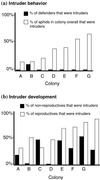Genetic conflict and conditional altruism in social aphid colonies
- PMID: 11562469
- PMCID: PMC59768
- DOI: 10.1073/pnas.201212698
Genetic conflict and conditional altruism in social aphid colonies
Abstract
Although kin selection is central to the modern study of social evolution, recent studies of social species have revealed that no simple relationship exists between levels of kinship and sociality. The soldier-producing aphids are unique among highly social animals because, barring movement by aphids between colonies, they occur in clonal groups of genetically identical individuals. Potentially, clonality simplifies efforts to understand social evolution in aphids by obviating issues of intragroup conflict. However, we report here high levels of clonal mixing and conflict in an aphid society. The gall-dwelling colonies of a social aphid species (Pemphigus obesinymphae) are not pure clones, but are invaded by large numbers of aphids from other clones. Intruders behave and develop selfishly once they have invaded a colony of nonkin. They refrain from risky defensive behaviors and accelerate their own development into reproductive rather than defensive stages. This conditionality in the social life of P. obesinymphae reveals complex dynamics and a degree of behavioral plasticity not previously known in aphid societies.
Figures


Comment in
-
Selfish responses by clone invaders.Proc Natl Acad Sci U S A. 2001 Oct 9;98(21):11839-41. doi: 10.1073/pnas.221450998. Proc Natl Acad Sci U S A. 2001. PMID: 11592993 Free PMC article. Review. No abstract available.
References
-
- Stern D L, Foster W A. Biol Rev. 1996;71:27–79. - PubMed
-
- Aoki S. Kontyu. 1977;45:333–334.
-
- Hamilton W D. In: The Biology of Social Insects. Breed M D, Michener C D, Evans H E, editors. Boulder, CO: Westview; 1997. pp. 81–102.
-
- Moran N A. Insect Soc. 1993;40:391–402.
-
- Foster W A, Northcott P A. In: Plant Galls: Organisms, Interactions, Populations. Williams M A J, editor. Oxford: Clarendon; 1994. pp. 161–182.
Publication types
MeSH terms
Substances
LinkOut - more resources
Full Text Sources
Other Literature Sources

